Landing
The best time to plant vines is early spring. For planting evergreen ivy, choose a suitable place. Ideal would be an elevated area where there is no stagnant groundwater, no drafts and strong winds, shaded from direct sunlight. The best soil option is loose, fertile, with a neutral or slightly alkaline reaction, with good aeration and moisture permeability.
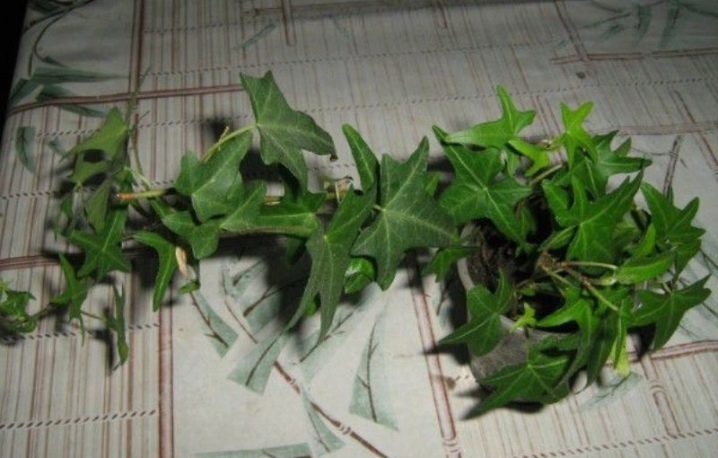
It is necessary to prepare the planting hole in such a way that the roots of the seedling fit freely into it during planting. A drainage layer is laid in the pit (fine gravel, pebbles are suitable) and a little soil mixture is poured. You can take a ready-made substrate purchased from a specialized store.
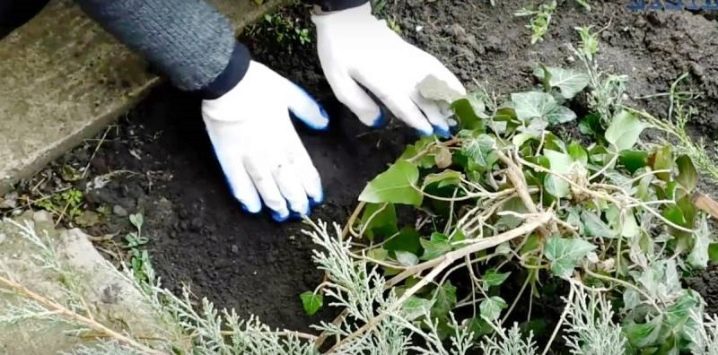
The prepared seedling is placed in a hole, the soil is laid and the near-stem zone is slightly compacted, then the plant is abundantly watered. When planting several seedlings, they are planted at a distance of half a meter from each other.
Ivy care procedures are not particularly difficult and do not contain any unthinkable manipulations. It is enough to carry out simple elements in a timely manner: watering, feeding, mulching, pruning, loosening the soil, preparing for winter, in accordance with the recommendations of florists.
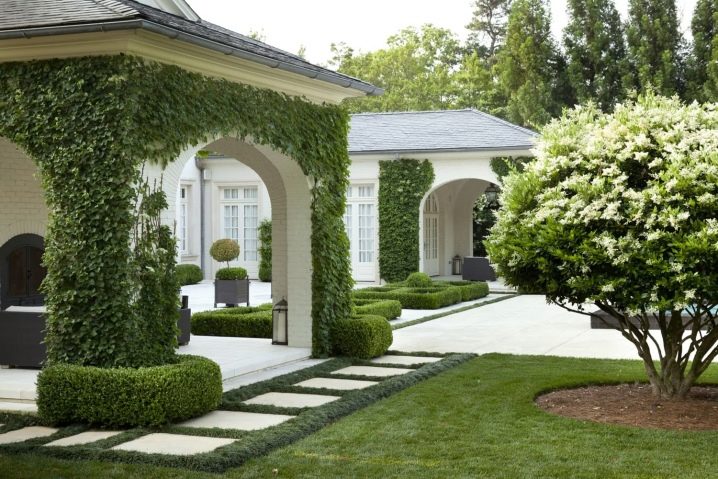
Watering
Proper watering is essential for healthy, ornamental garden ivy to grow. Do not water the plants too often or dry out the soil. The frequency of watering directly depends on weather conditions - during rains (depending on their intensity), watering is reduced, and in dry weather, it is increased. Determining the readiness of a plant for watering is quite simple - you need to check the soil under the vine and the condition of the leaves.

Mulching and loosening the soil
Periodic loosening of the soil under the headers and mulching with organic materials (fallen leaves, sawdust, peat chips) ensure optimal air exchange and moisture retention for successful rooting of young plants
The past heavy rains can "overwhelm" the soil, so you need to carefully loosen the soil, avoiding damage to the roots, in order to provide the root system with full breathing and moisture saturation. Spread a thin layer of mulch under the vines, and gradually increase its thickness as autumn approaches.

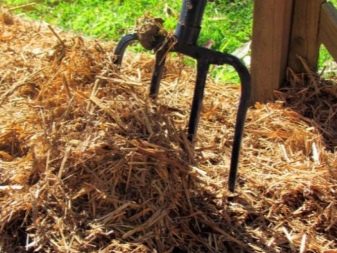
Top dressing
So that the street liana does not lose its decorative properties and decorates the landscape of the site, you need to periodically help it restore strength to form new shoots. For this, complex nitrogen-containing fertilizers are used at the beginning of summer. Since July, they switch to top dressing with potash and phosphorus fertilizers, which will help the plants to harden before wintering.
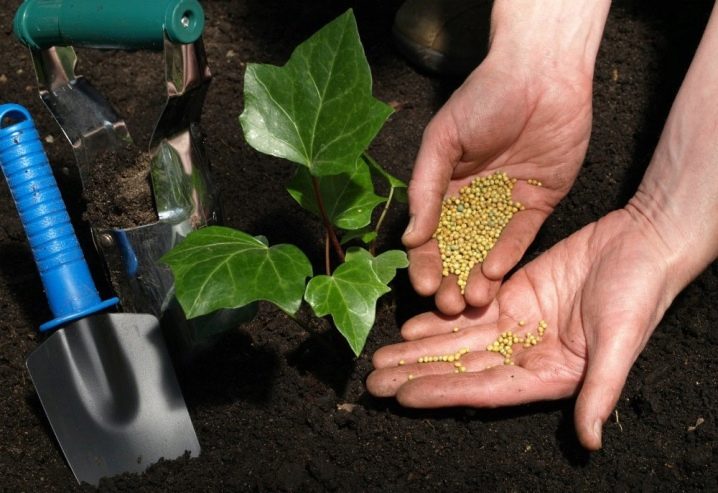
Pruning
To make farm buildings or hedges braided with vines look aesthetically pleasing, it is required to periodically trim and pinch the growing shoots. After pruning, ivy will have many side shoots, which will give the vine a more effective decorative effect. You can start pruning only after the end of the spring sap flow, which will come around the beginning of June.
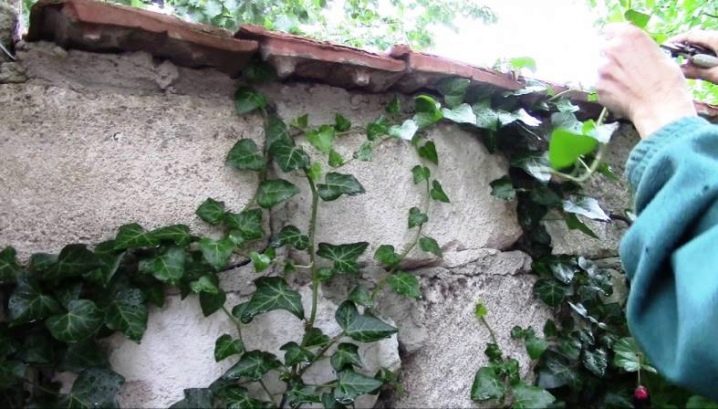
Preparing for winter
The high frost resistance of garden ivy allows them to do without winter shelters in areas with a mild climate. A layer of mulch and snow cover provide sufficient frost protection. In areas with colder winters, vines need to be covered for the winter. It is best to carefully remove them from the support, spread them on the ground and cover them with burlap, a special covering material, and coniferous spruce branches.
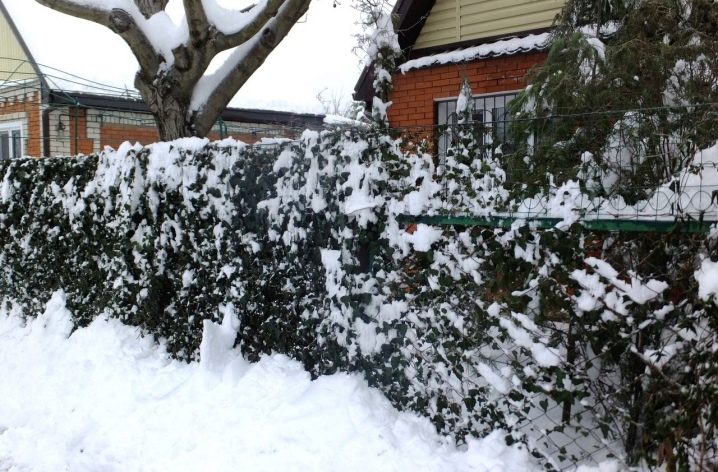
How to plant a green ivy fence
An evergreen ivy hedge can be a great backdrop for garden flowers, alpine slides, and even a playground. Therefore, the choice of a landing site must be taken seriously.But first you need to purchase seedlings.
Garden ivy propagates by cuttings, layering, shoots (ready-made seedlings). If there is nowhere to take cuttings, and even more so to make layering, then you need to choose seedlings in the nursery very carefully. Healthy leaves and roots are a sure sign of a strong plant. If there are doubts about the appearance of a young seedling, then it is better to refuse to buy it. A weak, unhealthy plant is unlikely to take root.
Ivy is an unassuming plant. It perfectly tolerates both heat and snowy cold winters. However, when choosing a place to plant it, it is better to avoid the sun. There are also no special requirements for the composition of soils. But, if we consider that this plant was brought to us from humid places with fertile soils, then the fertilizers applied will contribute to the splendor of the vines, as well as the exceptional shine of the foliage.
Ivy and maiden grapes are the perfect combination for hedges as they need the same conditions for good growth and development. This union has long been considered a symbol of wealth.
The best time to plant a hedge is from late April to late May. Before planting, you should make the necessary markings and install supports. Small pits are dug along the supports, the distance between which must be kept within half a meter. The diameter and depth should be such that the roots fit freely. The soil inside each hole must be thoroughly loosened and fertilized with compost or humus. After planting, abundant watering is required.
Initial work completed. Further, the plant grows and develops. As they grow, the shoots are tied to supports. In the very first summer season, the plant will braid all the supports and you will get a dense dense fence that will protect the site from dust, wind, and prying eyes.
Any support for hedges can be installed: wood, plastic, metal. A curly liana can also be launched along a netting net. For her, ordinary pillars with a wire stretched between them will be enough.
Garden design
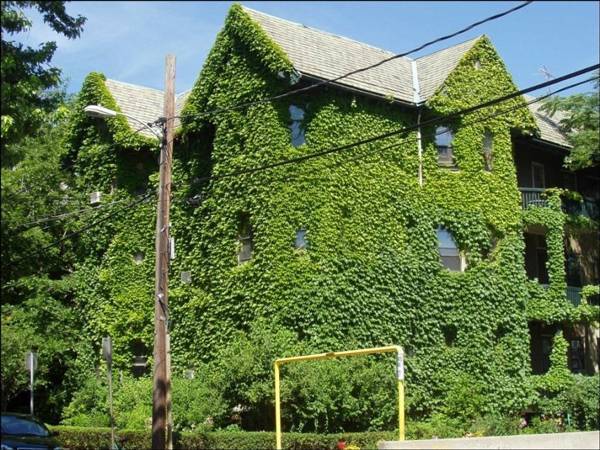
Florists constantly use the plant in landscape compositions at their dachas. Beautiful vines, entwining different buildings and hiding gray areas in the country, are a fabulous sight.

Hedge
Plants can transform an empty wall or gazebo. Grow well when paired with conifers or bushes. Subject to the rules of cultivation and good care, young climbing vines will decorate the house for many years. In order for the ivy that winds along the wall to please the eye, it must be periodically trimmed and prevented from diseases.
It grows very well and looks with a variety of trees, shrubs. For decoration, can be planted next to fuchsia. But mostly it is planted as a solitary plant.
The shrub is very effective in garden and dacha design and provides room for creativity. It is good for them to decorate a not too pleasant-looking facade of a building. A tree covered with ivy, green arbors, arches and columns will decorate any site.
A hedge is a great way to delineate an area.
The perennial is also used in the design of alpine slides. Varieties with small leaves will look beautiful.
Gardeners knowingly looked after this plant to decorate their plots. With proper care, ivy grows beautifully and will delight the eye for a long time on the street, on the wall of a house or on a fence with its decorative look.
Types and varieties of thuja
There are several varieties of thuja, but the most famous are the following types:
- western (the most famous variety is Smaragd, also common are Brabant, Danica, Teddy);
- eastern.
In the form of thuja there are:
- dwarf;
- columnar (pyramidal, conical);
- spherical.
As for the use of varieties of thuja in landscape design, then:
- to make a hedge, you are ideally suited for thuja of a columnar or pyramidal shape (the same Braband or Smaragd);
- for the design of walking garden paths, spherical thuja, both western (Danica) and eastern, are very useful;
- A rabatka or a small slide will be beautifully decorated with the help of dwarf thujas (Teddy). In general, thuja will be beautifully planted next to other conifers, for example, in combination with spruces or junipers.
Video: popular varieties of thuja for the garden
How to recognize diseases and spot pests. Combination with other plants
Ivy is considered an unpretentious plant, but it can get sick or be captured by pests at any moment.
It is important to recognize in a timely manner that the plant needs help, and take all measures to cure it.
Advice. If the ivy is attacked by pests or attacked by a disease, it is necessary to inspect all nearby growing crops.
- If the leaves began to turn yellow and fall off, the reason must be sought in the dryness of the soil. Having received sufficient watering, very soon the ivy will acquire new foliage.
- If the stems lose green leaves and quickly go bald, the ivy does not like the air. Usually, this phenomenon can occur in a sultry summer, in autumn. Therefore, the gardener is recommended to arrange water procedures for his plant every day.
- It is a bad sign if the variegated and bright green leaves suddenly faded. The root cause is that the plant receives little light. The problem can be solved only by landing in a new, more illuminated place.
Outdoor ivy cannot be protected from pest attacks. Aphids, scale insects, ticks are carried by insects and wind. Having found parasites on the leaves, stems, you should immediately begin the fight. To overcome them, it is necessary to spray ivy and all closely growing crops with actellik diluted with water, or karbofos. After the first spraying, it may not be possible to completely get rid of the pests. In this case, the procedure should be repeated after a few days.
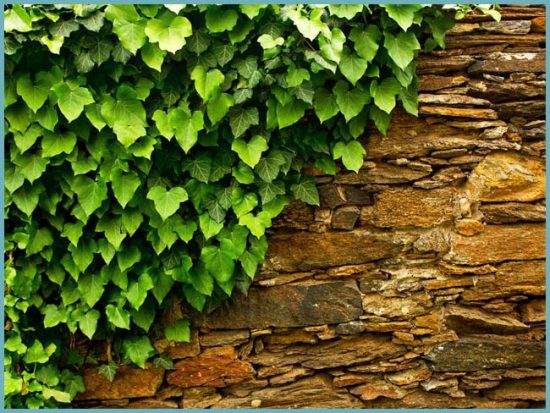 Ivy will perfectly decorate hedges
Ivy will perfectly decorate hedges
This plant is often planted near the fence, near the house, around the gazebos. Photos of buildings overgrown with ivy can be seen in magazines. Ivy, if you direct the branches along the supports as it grows, will become a worthy decoration of your personal plot. He is not afraid of any nearby growing neighbors, but not all plants are combined with ivy and can get along with it in the same territory.
Comfortably next to ivy will be coniferous, deciduous trees, ornamental shrubs. Landscape designers, give the idea of a combination and recommend planting this creeping plant in a garden with roses. Dark or variegated ivy greens will beautifully accentuate the foot of the queen of flowers.
Garden ivy, when it grows and gains strength, becomes very beautiful. When starting such a plant, you should be prepared that in order to give a neat aesthetic shape, the plant needs to be pruned regularly. Especially if it stretches up the supports, walls of the house, hedges. The rest of the plant is easy to care for. Having correctly chosen a place on the site, having organized watering, timely feeding and having tested the reproduction of a plant in practice, after a season you can become the owner of an incredibly beautiful garden ivy.
Types of garden ivy
Evergreen ivy (Hedera) is a climbing liana plant used since ancient times to decorate shady areas of the garden as a ground cover, as well as to create hedges. According to the descriptions, it can withstand frosts down to -18 °, but our conditions are tougher, but the vine hibernates even in vertical gardening.
- Colchis ivy (H. colchica) - with dark green large leaves 10-15 cm wide. Leaves are different in shape, most often whole-edged, weak-lobed, when rubbed have a specific celery smell. It blooms in autumn, flowers are collected in dense umbrellas, of little interest for decorative purposes. The most famous varieties are: the bushy (non-climbing) variety Arborescens and the garden form Dentata Variegata with leaves bordered with creamy white edges;
- Common ivy (H.helix) is one of the most winter-hardy species, reaching a height of 20 m.It climbs the rough surface of walls or trees with the help of aerial roots. Flowering shoots do not have roots, so they go down from the support, hanging over the main massif. Leaves are leathery, shiny three- and five-lobed. It also blooms in autumn with uninteresting flowers collected in a brush. It has a lot of decorative forms and varieties, differing in the configuration and color of the leaves: Professor Seneta - with green leaves on which there are cream streaks-spots, Goldhert - the main color of a three-lobed leaf is green, with a large yellow spot in the core;
In gardens, the most common is common ivy. It is the most unpretentious, it grows easily even in the shade, and its leaves have an interesting color, from green to yellowish and white.
Ivy types: photos, names and characteristics
In total, 15 species of ivy are widespread in Eurasia with huge leaves (15-20 cm) and miniature leaves, corrugated and smooth, of a variety of colors - yellow, gold, green, creamy white. In the western regions of Russia, in the Crimea and the Caucasus, common ivy grows wildly in shady deciduous forests.
As you can see in the photo, in forests, this type of ivy grows like a ligneous liana, climbing stems of which climb tall trees with the help of sucker roots:
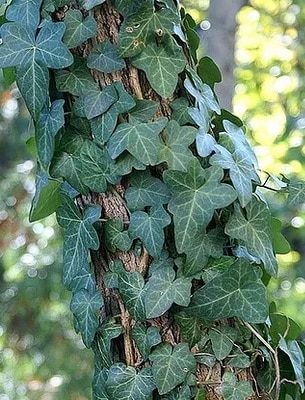
In mountainous regions, long ivy lashes stick with roots to the slightest cracks and roughness of rocks, sometimes covering them with a solid carpet. In central Russia, ivy withstands wintering only under snow. In culture, common ivy is grown as an ornamental plant, decorating, and as an indoor plant.
Common ivy has evergreen climbing stems about 3-5 m long, in favorable conditions they sometimes reach 20 m and even more. The ivy stalk clings to natural or artificial support (trees, trellises, frames, walls) with numerous aerial sucker roots. There are many varieties and forms of the plant.
Leathery, from above, shiny alternate leaves of various forms of common ivy are whole or 3-5-lobed. Most often they are of a noble dark green color with light veins. The leaves of some ivy varieties are variegated. Of particular interest are variegated forms with large and small golden yellow leaves.
Nondescript greenish flowers sit in globular umbrellas, collected in racemose or paniculate inflorescences. In culture, this ivy does not bloom.
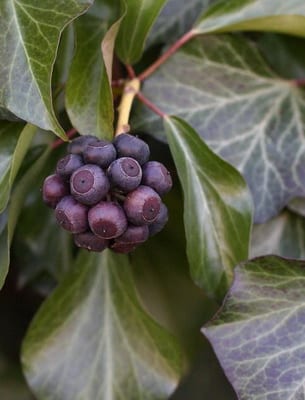
The fruits are very beautiful, but inedible berries, moreover, they are poisonous. When working with ivy, you should always remember that the plant is poisonous, not a single part of it should be eaten.
There are many varieties, garden forms and varieties of ivy. So, the Canary variety, native to the Canary Islands, has leathery heart-shaped leaves, green with a white pattern.
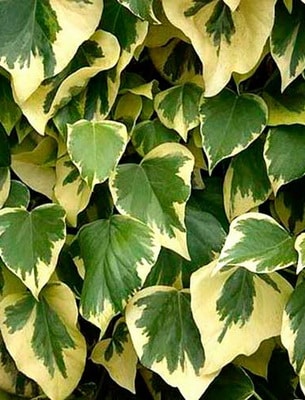
Known variety "Gluard de Marengo", very decorative and vigorous.
But mainly in gardening there are garden forms of common ivy with 3-5-lobed leaves. Description and photos of ivy varieties are given below.
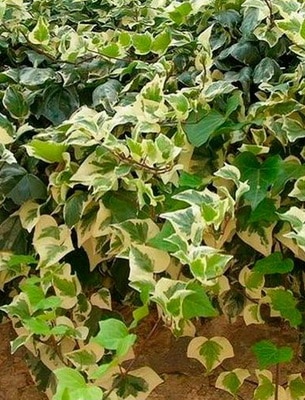
Brilliant golden - has small golden yellow leaves.
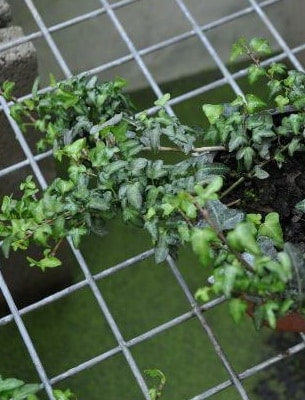
Small - the leaves are small, three-lobed, the shoots are strongly branched.
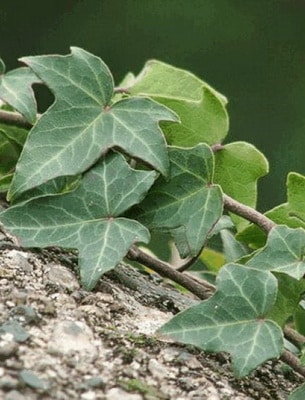
Fingered - leaves are five-lobed, dark green, with light veins.
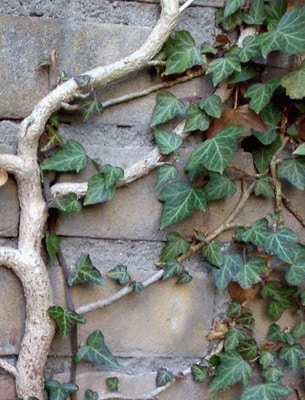
Crowded - the leaves are small, serrated, wavy along the edge, sitting tightly on the stem. It grows slowly.
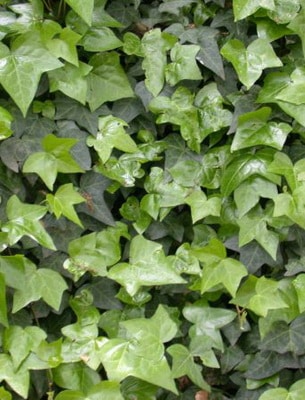
Arrowhead - five-lobed leaves with a medium blade length.

Triangular - small, three-lobed leaves with a heart-shaped base, dark green.
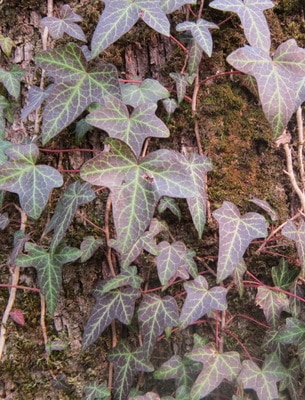
Tricolor - leaves with white edges, turn reddish in autumn. It also has reddish shoots.
Here you can see photos of popular ivy varieties:

Colchis ivy is the best in terms of decorative effect.
However, in central Russia, this form grows even more slowly.Variegated varieties are cultivated in European countries with milder climates.
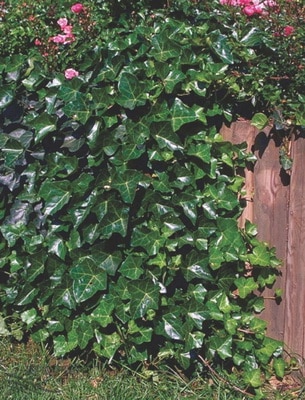
Irish ivy is a fairly fast-growing form that, with the help of sucker roots, is able to rise to a height of 6-20 m.
After 3-4 years, one plant can occupy an area of about 9 m2.
Blossoms in September and October with green-yellow spherical inflorescences. Small spherical fruits of black and blue color. Ornamental irish ivy is given by green, densely pubescent shoots with gray hairs with dark brown-red ends.
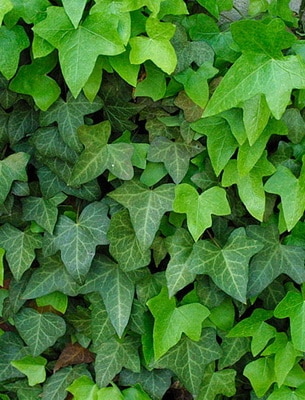
Garden ivy is a climbing perennial plant whose appearance changes with age.
As the name suggests, this type of ivy is only suitable for outdoor cultivation. It has many varieties that differ in shape, size (up to 20 cm) and leaf color.
Growing ivy from cuttings
Cutting is a fairly simple way to get planting material. Many species of ivy grow so quickly that the plant will not even notice the loss of a few shoots.
Video: ivy propagation by cuttings
Procurement terms
Harvesting should be done in late spring or throughout the summer. It should be remembered that only a lignified shoot is used as a cutting. It is better not to touch young watery green shoots, since they take root very slowly, and under unfavorable conditions (sudden cold snap or high humidity) they begin to rot.
In autumn, it is better not to carry out cuttings, since the plant is preparing for wintering, accordingly, it does not build up additional shoots, but stores nutrients in the aboveground and underground parts. If you cut a few branches, then the small bush may have problems and will not survive the winter. 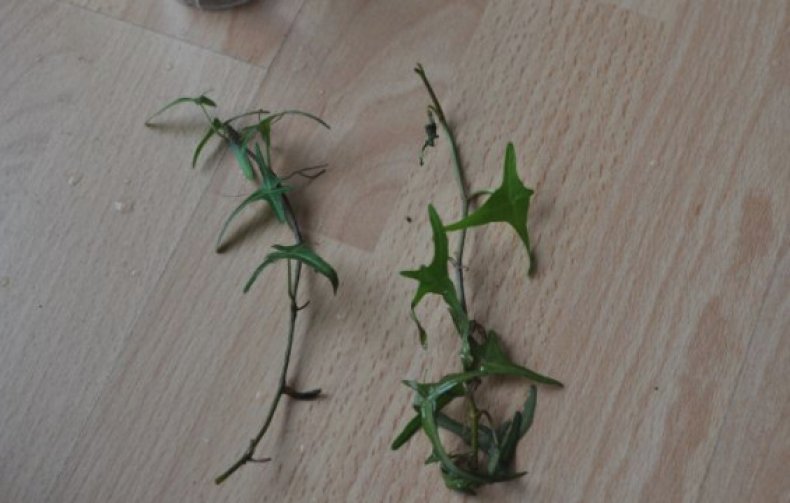
How to prepare and root cuttings
For reproduction, annual shoots are used, on which there are small adventitious roots, or rudiments are visible. Next, you should measure 10-14 cm, and then make an oblique cut. The cutting should have healthy leaves and at least one formed knot.
Video: rooting ivy cuttings using perlite Next, all the lower leaves (near the cut) are removed, after which the lower part of the shoot is dipped into a growth stimulator of the root system. After that, the cutting is planted in a mixture of sand and earth in a 1: 1 ratio.
If the weather is fine outside, then the ivy pots / boxes can be taken outside. Otherwise, it is better to leave the containers with cuttings in a greenhouse or well-lit room.
After 1.5 months, you can safely plant the plant in a permanent place.
Landing rules
When choosing a permanent place for a young plant, it should be borne in mind that ivy loves shade or partial shade, as well as sufficiently nutritious soil.
Video: how to plant ivy If good soils are already occupied, then add a small amount of humus or compost when planting. After that, it will be enough to maintain the humidity.
Be sure to pay attention to the acidity of the substrate. Ivy will die if planted in acidic soils.
The reaction should be neutral or alkaline.
The best place for ivy is a damp area under the crown of a large tree, which is adjacent to the fence. In such a place, ivy will not only grow well, but will also decorate the hedge.
In large open areas, the plant will be useless, and you will have to take care of it as a demanding crop, since in the absence of shade, moisture will evaporate from the substrate much faster.
How to grow ivy and how to care for it
Common ivy is an unpretentious perennial plant that grows on all types of soil, is drought-resistant and photophilous, tolerates frost well. Although it can grow in deep shade and withstand heavy shade, it develops faster when exposed to direct morning or evening sunlight.
With a lack of light, their variegated color of leaves fades and even disappears, but they should be protected from direct sunlight. Almost any soil is suitable for ordinary ivy, with the exception of clay. It grows well in fertile and sandy soil, a clay mixture is best suited.
Irish ivy is more frost-hardy than common ivy, but suffers from frost. It tolerates partial shade and full shade; in the open sun it can burn out. It grows on all soils except pure peat.
When caring for ivy in the garden, when growing a hedge, supports are prepared in advance. These can be poles with wire stretched over them, or a wooden fence, or metal or plastic mesh.
Light-loving plants can be recognized by the color of the foliage. They usually have light green and variegated leaves and grow better in strong light.

To plant ivy, holes are dug along the supports of such a depth that the roots of the seedling are fully placed in them. Planting holes are dug at a distance of about 50 cm from each other.
The bush is planted obliquely so that, once rooted, the plant can climb the necessary supports or stones. At least 25 rooted cuttings are planted for each m2. After planting, the seedlings must be watered.
The growing shoots are directed to the support, which is supposed to be planted. After planting ivy, with proper summer care, it will creep over the supports with a dense wall and become reliable protection from wind and dust.
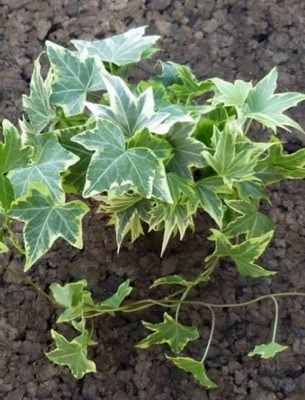
Ivy seedlings with a closed root system are planted from March to November, including on hot summer days, without purchasing additional fertilizers.
Watering ivy during care when growing in the garden is necessary within reasonable limits so that the plant has enough moisture and the earth does not dry out. The soil should be moist, but it should not be excessively waterlogged.
In hot, dry weather, at temperatures above +21 ° C, it is recommended to spray the ivy leaves on top, which will allow them to remain fresh and clean. In addition, spraying regularly with water will keep the plant free from red spider mites.
Pruning fast-growing ivy is carried out regularly, removing excess shoots, dry and damaged. Systematic pruning and shortening of unevenly growing shoots keeps ivy within the defined fence contour.
These photos show the techniques for caring for ivy in the street:
To protect garden ivy in winter, the soil under it in the fall is mulched with a sufficient layer of peat or humus so that it does not freeze. Ivy stems on low curbs are covered for the winter with dry foliage of an apple, hazel or oak tree.
Ivy rarely infest pests and diseases. However, common ivy can sometimes be affected by spider mites.
Irish ivy is harmed by scale insects and ticks. For prophylaxis, when caring for ivy, plants are regularly, but within reasonable limits, sprayed with insecticide at the dose indicated on the package.

Against the scale insects, spider mites, aphids, treatment with karbofos, "Aktara", and also "Aktellik" (1-2 ml per 1 liter of water) gives good results.
If ivy has been infected with a spider mite, then silvery dots will appear on the front side of the leaves, and spider threads will appear below. In this case, it is sprayed with water and treated with a special anti-pest preparation.
Growing features
Soil selection and planting site
Garden ivy is an unpretentious plant, it grows on almost any soil, except clay, which delays the flow of oxygen to the root system. What's more, clay can trap moisture, which can lead to rotting of ivy roots.
The best option for growing will be a soil with lime and humus, that is, a moisture-absorbing and breathable substrate.
Variegated varieties of garden ivy are planted on the sunny side, choosing a place in such a way as to prevent direct sunlight. For plants with dark green foliage, choose a shady place.There should be a support for the vine next to the planting.
Temperature, humidity, watering
The development of the plant in the first two years after planting is rather slow. In this regard, it is recommended to plant ivy in open ground in the spring, so that in the warm season the plant has time to get stronger and gain a foothold, and its root system grows.
Garden ivy normally tolerates changes in ambient temperature. However, for growing in regions of our country, where there are often cold winters, you should definitely choose frost-resistant species.
Being in dry air can cause the leaves to dry out and die. In this regard, regular spraying of the leaves may be required.
Since garden ivy is a moisture-loving plant, care should be taken to ensure that the substrate in which it grows is always moist. Moreover, ivy loves spraying, so it is mainly watered with sprinkling. In the summer they water it often enough, at least 1-2 times a week, making sure that the earthy clod does not dry out; in winter, watering the plant should be reduced.
Loosening
Garden ivy needs regular loosening of the soil. If the soil has dried up from insufficient watering, it is watered abundantly and loosened. Loosening is also carried out to prevent the appearance of earth crusts after rain. The loosening process helps and increases the air permeability of the soil layer
However, this should be done carefully so as not to damage the roots.
Fertilizer and feeding
To speed up the growth of the plant in the spring and summer, it is recommended to feed the garden ivy once every two weeks. For feeding, fertilizers for ornamental plants, which include nitrogen, should be used. In order for the plant to endure the winter better, starting from the middle of summer, you can feed it with fertilizers with the presence of potassium and phosphorus.
Transfer
Garden ivy does not tolerate transplanting well. Gardeners should carefully choose a planting site, keeping in mind that the plant may die as a result of transplanting.
Pruning
Garden ivy is pruned in the fall, removing excess shoots and dry leaves. Long shoots are shortened. In order to grow a lush plant, it is necessary to cut off all the tips of the shoots.
Cutting points must be treated with garden varnish, which will help the plant heal faster, and also prevent the entry of pathogenic bacteria, parasites and insects that can cause ivy to die.
Garden pitch can be purchased in specialized stores, or you can prepare it yourself using 3 parts of paraffin, 1.5 parts of rosin and 1 part of vegetable oil. When self-preparing the product, the paraffin is melted in a water bath, after which rosin powder is added to it, and after boiling, vegetable oil is added. The resulting mass should be boiled for 30 minutes, then cooled and transferred to a container with a lid.
Preparing ivy for winter
Frost-resistant varieties of garden evergreen ivy winter well in the middle lane. However, in the northern regions of our country, ivy used for vertical gardening can die due to low temperatures. In this case, ground cover plants turn out to be more tenacious, which winter comfortably under a layer of snow. Plants can also be covered with burlap, fallen leaves or twigs.
Lianas growing on vertical surfaces in the southern regions can be left on supports, and in the northern regions they can be removed and insulated like ground cover plants.
This is interesting: Pumpkin juice at home for the winter - a step-by-step recipe with a photo
Features of selection and landing
Before purchasing seedlings, it is worth assessing the conditions in which the greens will grow and your preferences. The choice must be influenced by:
- climate;
- conditions of care;
- the specificity of the plant.
For cold winters, weaving winter-hardy plants are suitable, growing quickly enough, and, if possible, were unpretentious. Therefore, when choosing, you can think about your preferences and capabilities, for example, what the plants will be:
- annual or perennial;
- flowers or decorative foliage will be the main decoration;
- evergreen (for warm climates) or deciduous;
- prickly or thornless;
- light-loving or shade-tolerant?
You also need to think about a support on which the greens can creep or curl. If this is a fence, then its prevention should be done, otherwise after the growth of greenery it will be more difficult to do it.


